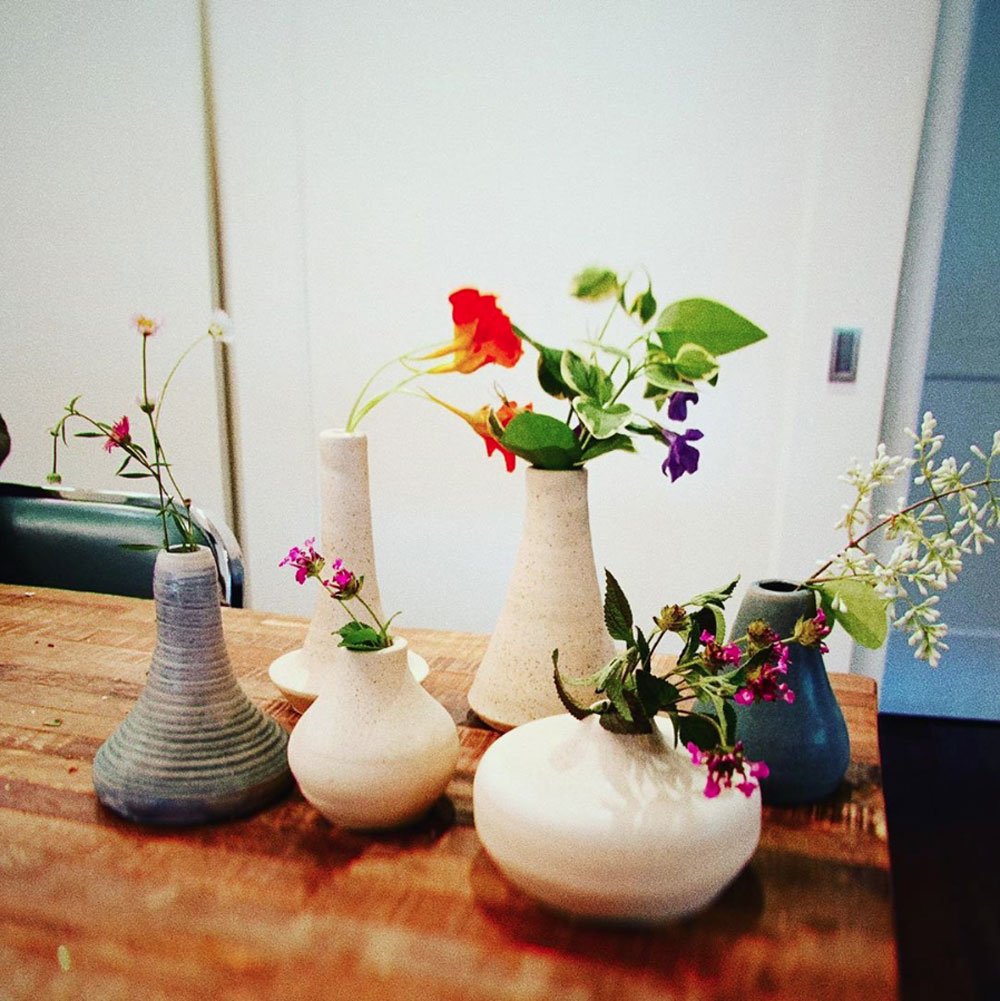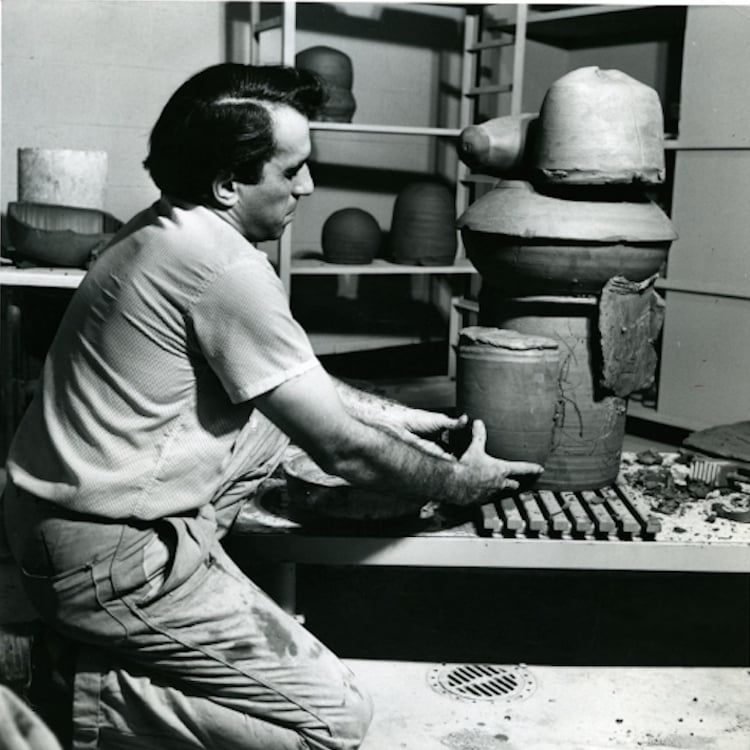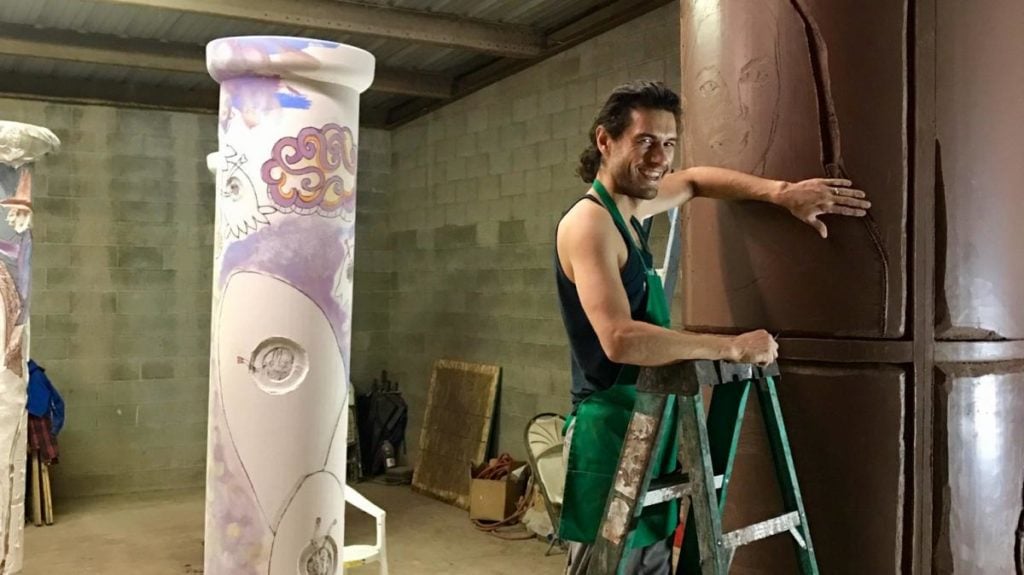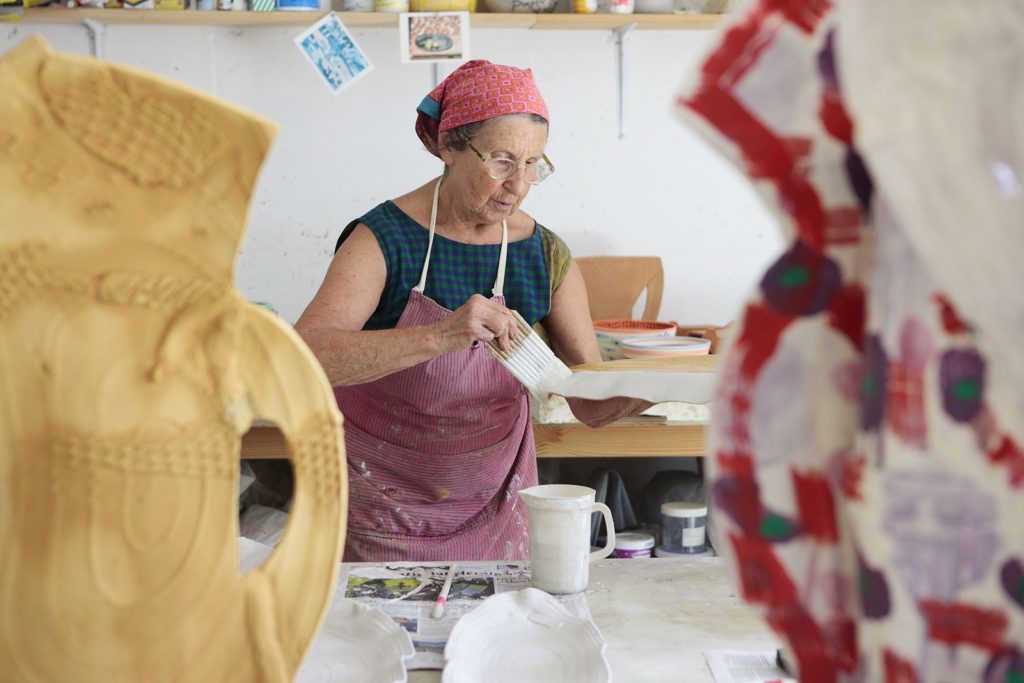Art World
Celebrities From Brad Pitt to Seth Rogen Are Massively Into Pottery. Here’s a Primer on Bro-ramics (and Its Colorful, Fraught History)
We set out to discover why ceramics are taking the world of A-list bros by storm.

We set out to discover why ceramics are taking the world of A-list bros by storm.

Katie White

If you follow the celebrity-artist circuit, you may have picked up on a trend of late—Hollywood bros are into getting into ceramics hard.
Seth Rogen and James Franco, who both burst into the public imagination as misfit teenage stoners on the TV comedy Freaks & Geeks, have each added the title of “ceramicist” to their resumes in recent years.
In 2017, actor and art-world dilettante Franco teamed up with his brother Tom to collaborate on a series of enormous ceramic sewer-pipe sculptures, which were displayed at the Ceramics Research Center at the Arizona State University Art Museum. (Granted, audiences may now be less interested in Franco’s ceramic dabblings, given persistent accusations of sexual misconduct.)
Rogen, meanwhile has taken up the medium with earnest devotion, posting images of his vases and ashtrays on social media. “I didn’t know I would like it as much as I do,” the actor told Ben Barna in a recent conversation in Interview magazine. Rogen and his wife, the actress Lauren Miller, “joined a studio near our house in Los Angeles, and we just found ourselves, in every moment we could, wanting to go and do it more.”

Seth Rogen’s handmade ceramic vases. Courtesy of the artist’s Twitter.
Franco and Rogen are not the only converts. Artnet News recently reported that “Once Upon a Time…in Hollywood” stars Brad Pitt and Leonardo DiCaprio have been pulling late nights in Pitt’s sculpture studio, making ceramics and eating sandwiches. A source told The Sun, who first reported the news, that “They sometimes hang out with Brad’s artist pals, but other times it’s just the two of them. Leo brings sandwiches over from their favorite place, Fat Sal’s, and they spend their boys’ nights creating art until the early hours.” So wholesome!
And the list of ceramics bros might be growing. When Shia LaBouef (another Freaks & Geeks alum) told Twilight actress Kristen Stewart he was “deeply dissatisfied with life,” she suggested taking a pottery class.
So why the sudden enthusiasm for ceramics? We asked some ceramics experts, who happen to be guys: What exactly is going on here?
First of all, the idea of the ruffian ceramics dude dates back decades. In the 1960s and ‘70s the West Coast ceramicist Peter Voulkos defined the macho ceramicist aesthetic, making bold ceramic creations that dismantled the divide between craft and high art.
An outsized persona, Voulkos sometimes plied his craft before enraptured live audiences, the ceramics world’s very own hibachi chef. Other talented bros stood up to proclaim that clay was serious business. Ken Price left his mark as a renegade, declaring himself a “fine artist” from the start. Robert Arneson, a California artist and father of Funk Art, carved out the stoner-ceramicist archetype with his humorous and rebellious ceramic self-portraits.

Peter Voulkos. Courtesy of photographer Oppi Untracht/American Craft Council Library and Archives.
Garth Johnson, curator of the 2017 Franco brothers exhibition and current curator of ceramics the Everson Museum, says there was a “Montana contingent” to this mid-century crew, too. This was a group of male ceramicists—made up mostly of World War II and Korean War vets including Rudy Autio, and Henry and Peter Meloy—all plying their craft in Big Sky Country.
“They smoked, drank…womanized. The stories can be blood-curdling. It’s all about fire and pyromania in a way,” Johnson mused. These artists discovered pottery amid the post-war American “Greatest Generation” zeal—years in which, both coincidentally and not, ceramics ultimately became an entrenched subject in academia.
Adam Welch, director of New York’s Greenwich House Pottery, one of the largest ceramics studios in the city, admitted that there’s always been a strong bro undercurrent within the field. “Sure, there’s always been that manly man guy, and because of the ways society is and has been, they get attention and, for better or worse tend to be well-known,” he said. “They get to be the famous ones.”
You really shouldn’t get behind the wheel high, except when it’s a ceramics wheel, in which case a little green appears to be a bro-requisite. There’s no denying that the macho enthusiasm for ceramics is glazed with a dash of cannabis.
Brad Pitt recently winked at his habit during the Screen Actors Guild Awards acceptance speech. James Franco, on the other hand, claims to never touch the stuff, which some find unlikely, given his impeccable performance in Pineapple Express.

Tom Franco at the exhibition “Pipe Brothers: Tom and James Franco” at the ASU Art Museum Ceramics Research Center. Courtesy of the artist and the ASU Art Museum Ceramics Research Center.
The most openly avowed toker of the lot, Seth Rogen, found stardom playing a sweet, stoner slouch, and recently turned his hand toward the business of getting high, launching Houseplant, his own cannabis company. Perhaps a shock to no one, it’s his love of getting blazed that’s fueling his kiln, dare we say. “I smoke joints all day, I interact with [ashtrays] a lot,” Rogen told Barna in Interview. ” I’m always looking for a little place to rest my joints—a little bed—so this became the perfect chance for me to create the exact ashtray I wanted,” adding that there’s “no activity I do that I don’t smoke weed while doing, and pottery is no exception.”
The heady fumes of pot culture aren’t just wafting from the amateur’s corner, either. Dean Roper, a classically trained contemporary ceramicist, has earned a significant following with his quirky sculptures of everything from Supreme skatewear to bongs (so as to leave no doubt about his passions, Roper’s Instagram handle is superchillandcool420). Roper explained that his urge to make bongs and pipes came from a desire to lovingly embody “shit-head high-schoolers trying to sneak bongs through the kiln,” or to conjure the sort of “clay blobs” made by kids at summer camp that later “got repurposed into their parents’ ashtrays.”
Rogen seems to think so, telling GQ writer Caroline McCloskey: “It’s like yoga, if you got a thing at the end. If you were doing yoga and then some object was produced at the end of it.”
Welch said that the sense of concentration and bodily awareness needed to make ceramics, along with the ethos of a “practice,” do align with elements of yoga. But Johnson doesn’t exactly agree; while there may be some similarities, ceramics can be a whole lot more stressful. It’s “a nightmarish medium to work with,” he cautioned. “It’s plagued with technical issues.”
“When you’re in the zone, there’s nothing like it,” Johnson conceded. “But ceramic artists have to be really strong personalities to overcome the adversity that the medium presents.”
In any case, it’s possible that the bro-enthusiasm for ceramic arts is just part of the medium’s period resurgence in popularity.
“I started working in ceramics during junior high, so that’s 26 years,” Welch said. “And I’ve seen these sorts of cycles of popularity. Even that scene in Ghost with Demi Moore and Patrick Swayze—there was a boost. Though some people in ceramics circles hate the reference, there was definitely a jolt of excitement in the scene when that came out.”

Leonardo DiCaprio and Brad Pitt in Cannes. Photo by P. Lehman / Barcroft Media via Getty Images.
What all voices seem to agree on is that the haptic experience of working with the earth, of carefully building and firing works, is something more people—not just men—are actively seeking in the age of constant screen time.
But for some men, the experience might reestablish or enforce ideas about a masculine connection to nature, ventured Sohrab Mohebbi, curator at SculptureCenter.
“I think ‘bros’ like to represent some kind of primordial relationship with the source, nature, or the earth, let’s say. So shaping the earth [or] clay, and turning it into objects, functional or otherwise, seems to show how they emerge out of nature and self-actualize,” he pondered.
This side of pottery is nothing new, with roots in the ceramics boom of the 1970s, alongside other DIY trends including food-world activism. “Ceramics were considered a holistic activity and product” said Johnson. “This boom ranged from people painting greenware figurines to back-to-the land types who became serious potters.”
“A lot of those masculine guys were on the GI bill and studied art, primarily ceramics, as an art-therapy exercise,” said Roper. “After the war many of them adopted clay as a primary medium because it was familiar to them. I see so many different people getting into ceramics, though the cliche hippy is definitely a real thing.”
Welch, meanwhile, pinpoints the current resurgence in ceramics to a maturation of the “craft” and artisanal waves that swept through hipster culture in the early 2000s. The act of making ceramics, then, provides amateurs a way out of the abstracted digital tangle of daily life and gives them a way back into their own bodies. “We live three-dimensionally, not two-dimensionally,” offered Welch. “Working with clay, with the earth, in three-dimensions—I hate to say it, but there really is something primordial to it, about connecting back to nature.”
Sure, it’s great that Seth Rogen and Brad Pitt are having fun, but pottery bros need step out of the spotlight. What’s not up for debate is that ceramics in America developed as a female-dominated and developed field dating back to the 19th century, when painting ceramics became an immensely popular hobby for women.
“The most important makers in ceramics throughout history have been women,” Welch emphasized and cited the “Cincinnati women”: Mary Louise McLaughlin and Maria Longworth Nichols Storer, two Ohio-based artists and businesswomen who transformed the American ceramics market in the late 19th century. “They made ceramics famous way back when,” Welch said. “Then men came in, took over the factories, and wrote them out.”
And while there may have been a “macho” strain to ceramics mid-century, an enormous gender parity existed in those years too. “The most important figures in the ceramics world in that era were women” said Johnson, naming Marguerite Wildenhain, Betty Woodman, and Viola Frey as a handful of the leading visionaries. “But very few reached the upper echelons of the academic world,”Johnson said. “Which is…fucked.”

Betty Woodman. Photo: Stefano Porcinai, courtesy of Salon 94.
Today, women still dominate the field as students and as practitioners— though they may not get as much attention for it. Welch ventured the unscientific estimate that 92 percent of Greenwich House Pottery students are women.
While the Brad Pitts and Seth Rogens of the world are illustrating that ceramic art is currently the popular kid in the hobby class, we should note that this popularity is largely owed to the diverse array of women, as well as to LGBTQ and non-white artists who have driven its resurgence. That includes talents like Roberto Lugo, Grayson Perry, Simone Leigh, Shio Kusaka, and so many others.
All the experts seem to feel the attention paid to the “bro” strain of ceramics is largely out of proportion—but they welcome the enthusiasm and visibility it brings to a medium that has long been sidelined.
“The hobbyist wave of the 1970s actually paid off in terms of building two decades of support for high-end works in craft materials, and I am guessing that this wave of popularity will actually integrate with energy from art galleries and produce less ghettoization of clay in the future,” said Johnson. “The popularity may wax and wane, but I don’t think we’ll return to anything like the material biases that existed in the late 20th century…and Seth Rogen will turn to underwater basket-weaving, eventually.”